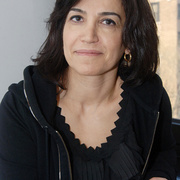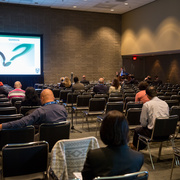
Choose a channel
Check out the different Progress in Mind content channels.

Progress in Mind



Artificial intelligence is a term that conjures up images of robots and machines capable of intelligent thought. In the field of psychiatry, artificial intelligence principles and practices are being used to take neuroimaging data and develop biomarkers that could support a clinical diagnosis and quantify and describe that diagnosis.
Dr Mitsuo Kawato of the ATR Computational Neuroscience Laboratories in Kyoto, Japan, has been involved in research that for the first time defines the biological dimension – an imaging dimension – of a psychiatric diagnosis. Research published by Dr Kawato and colleagues in Nature Communications in 2016 ranked among the top 1% of viewed scientific papers published in same period. Dr Kawato believes this is because the paper dealt with an artificial intelligence application that could define autism spectrum disorder (ASD) using neuroimaging-based classifiers – or biomarkers. The research team are using the application to define and create neuroimaging biomarkers for major depressive disorder (MDD), schizophrenia, obsessive compulsive disorder (OCD) and chronic pain syndromes.
Taking data from 200 patient samples, and looking at 10,000 neuroimaged connections and 140 brain lesions, Dr Kawato said it had been possible, using sophisticated artificial intelligence algorithms, to select the 16 functional connections that are specific for and discriminate ASD from normal (typically developed) brains. He explained that this type of computational neuroscience allows the description of one scale – one dimension – that plots the Gaussian distribution for typically developed individuals and another that plots the distribution for, in this case, ASD. This biomarker tool therefore also allows for a quantitative assessment – or score for the diagnosis.
What is more, Dr Kawato explained that these neuroimaging biomarkers being developed not only define and describe a specific diagnosis, but highlight distinctions between diagnoses and similarities and closeness of certain diagnoses. For example he said that the ASD neuroimaging biomarker could not distinguish MDD patients from their controls, but showed some ability to discriminate between patients with schizophrenia and controls. According to Dr Kawato, this closeness between ASD and schizophrenia is in keeping with historical views that these conditions shared some commonality and with genetic studies indicating common loci for schizophrenia and ASD.
Dr Kawato believes that neuroimaging biomarkers will be a valuable support to clinical diagnosis and will become a reality of practice and diagnosis in the near future. He told Progress in Mind: “In other disciplines of medicine like cardiovascular medicine and oncology for example, it is common to examine biomarkers – be they blood biomarkers or imaging scans (fMRI and PET). But in psychiatry, we haven’t had that kind of quantitative measurement to support the clinical diagnosis.”
“We had two objectives. The first was to provide objective scales to support clinical diagnosis with neuroimaginging based biomarkers.” Dr Kawato then said that if these biomarkers prove to be really reliable, it may be possible to use these tools to explore and describe the neurocircuits and brain regions with correlates for predicting certain diagnosis.
Dr Kawato described how the neuroimaging biomarker looks at resting state fMRI, with a 5-10 minute scan providing the data to allow a quantitative diagnosis. He said that in the future it might be possible, not just to diagnose one condition, but to use all the available biomarker scales to see if, in the case of ASD for example, a person has a condition more predominantly located between ASD and schizophrenia – or located closer to the normal healthy position.
These developments in neuroimaging biomarker research might also have applications in the management of psychiatric disorders. Dr Kawato said that real-time feedback based on imaging biomarkers might have therapeutic applications in some diagnoses. He explained: “We can define “ASDness” and then in realtime we can feed this back to our patient as a score. It’s something a bit like cognitive behavioural therapy or psychotherapy, although a little bit more high tech.” Dr Kawato said that pilot studies in ASD, MDD and chronic pain conditions, have been looking at this real-time feedback. According to Dr Kawato, outcomes may depend on the learning capability of a given patient and some conditions may be more amenable to reinforcement conditioning than others.
For the future, Dr Kawato said that neuroimaging biomarkers may soon become a clinical reality and he hoped that machine learning algorithms based on biomarkers might also find a place as another modality in the management of psychiatric disorders.
Computational neuropsychiatry is a new discipline, exciting huge interest for its potential in diagnosis and possibly even management.




Imagine if one working week every month your work performance was limited or compromised. That’s the situation faced by many schizophrenia caregivers who also hold down paid jobs, according to the findings of a large-scale caregiver survey presented by Dr Debra Lerner of the Tufts Medical Center, Boston, at the 2016 APA congress.
Dr Lerner said that over 18% of adults in the US act as unpaid caregivers, and she cited the findings from On Pins and Needles study which showed that three quarters of caregivers looking after someone with mental health issues find the task emotionally stressful.
Many caregivers to people with schizophrenia and schizoaffective disorder work, and Dr Lerner therefore said it was important to try to understand the impact that their caregiving had on work function and productivity. To this end, Dr Lerner got involved in conducting a survey of caregivers who also worked, asking about their paid work commitments and employment.
She described the anonymous on-line survey, which included a number of validated tools such as the work limitations questionnaire (WLQ), designed to assess time lost from work (absenteeism), presenteeism and impact of caregiving on work productivity.
Results from over 1000 caregiver questionnaires were available for analysis, and showed that the average age of caregivers was 55 years, with the average age of the care-recipient 40 years. Most caregivers were women and most were the parent of the person with schizophrenia or schizoaffective disorder.
Over 60% of caregiver respondents were in current work and of those, 69% reported being in full time work. Dr Lerner said that these statistics showing high rates of full time work among carers, emphasized the need to make things easier for caregivers, particularly as the survey showed that most worked outside of the home and many had lengthy commutes to their place of work.
Over a quarter of caregivers in work said they often had to take time off work but more than half said it was difficult to take time away from work for personal matters. Missing an average of 0.6 days per week from work and associated with work productivity losses of around 8%, Dr Lerner said that caregivers had work losses that are equivalent to those experienced by patients with MDD.
The survey highlights that being a caregiver to a person with schizophrenia spills over into work – with a negative impact on productivity. More research is needed to understand and quantify the burdens on those who care for people with serious mental illness.
Hot on the heels of a study showing that at least 8.4 million Americans provide care to an adult with an emotional or mental health issue, comes further information highlighting caregiver burden.